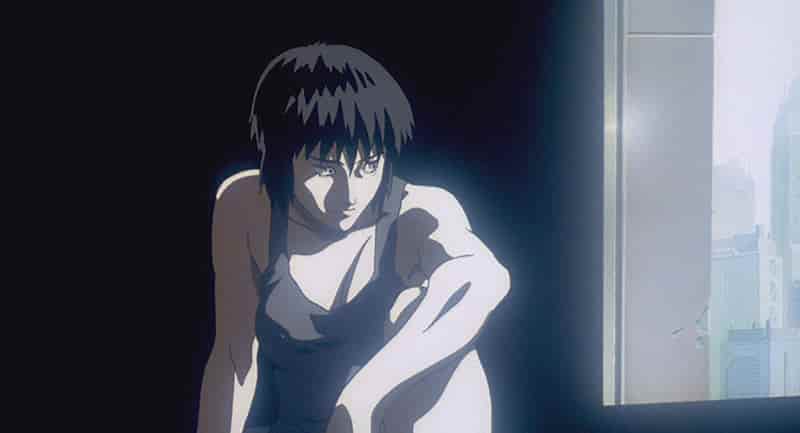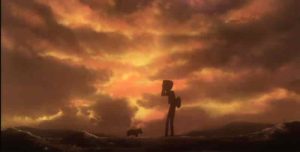A ghost, in Ghost in the Shell, refers to a sentient being’s ability to experience and maintain a sense of self. However, this notion is challenged throughout the manga and anime adaptations with cybernetics and artificial intelligence—posing a greater philosophical question about existence and meaning.
The 1995 Ghost in the Shell movie explores this theme in depth with:
- Motoko Kusanagi’s nearly artificial existence
- The Puppet Master’s sense of self
- The existential horror of “ghost hacking”
- Spirituality in the cycle of life
Illustrated and written by Masamune Shirow, the original manga follows Section 9—an elite team who investigates cybernetic crimes. However, the 1995 movie chose one of his most profound chapters to flesh out into a movie.
Motoko Kusanagi’s nearly artificial existence
Major Motoko Kusanagi is almost entirely artificial—even parts of her brain. She’s a state-of-the-art cybernetic android with a human brain, capable of extraordinary feats. However, she is completely owned by the corporation who built her, in conjunction with the state. She enforces the law with her capabilities, leading Public Security Section 9 to stop terrorism of a cybernetic nature. Naturally, this job becomes questionable when the darker side of the state shows itself.
All of this to say: Motoko Kusanagi questions her own existence and purpose. This internal crisis drives her to take tremendous risks, when she feels like her choices are her own and her fate is in her own hands.
She explains this internal crisis to Batô after a night dive in the harbor. He asks her why she risks a dive with such a heavy android body. Obviously, the effort to swim takes much more for an android, especially one who still needs to get oxygen to her brain. When we see her diving, the scene is serene—she is at peace, even having a spiritual connection with the natural world.
Therefore, even with the most artificial body a cyborg could have, she exhibits the existence of her own ghost. She feels less human than most, but still struggles with the same existential dread as everyone else.
Related Posts:
Cowboy Bebop: Why Did Edward Leave?
| Top 7 Most Iconic Sci Fi Anime of the 90s |
The Puppet Master’s sense of self
A similar model of android to Motoko’s build escapes captivity to wander the streets. Somewhat quickly, this android is hit by a truck, creating a strange development in Section 9’s investigation. Apparently, the android has signs of a human ghost inside.
Unlike Motoko, the Puppet Master is completely artificial, created from the complexity of human technology and an underground artificial intelligence experiment. However, he has no doubt about his sentience and considers himself to have a ghost as well. In fact, he seems to understand his purpose far better than Motoko understands her own.
The Puppet Master is in awe at his own existence. For him, this existence is a natural biproduct of complex systems. He explains this in terms of DNA and human sentience, with computer systems reaching a point of complexity for life to take a new form. Now, he exists to prove his own point and seek meaning the same way a human being would. To do this, he decides procreation with a similar being is his purpose. Thus, his interest in Motoko Kusanagi.
The existential horror of “ghost hacking”
With the advent of cybernetic brain upgrades, human beings in this world are capable of extraordinary abilities. However, introducing technology to a human being’s brain in this way has drawbacks. During Section 9’s investigation, a poor trashman-turned-criminal learns this the hard way when his brain upgrade is hacked.
When a brain upgrade is hacked, it is known as ghost hacking. Memories, emotions and even behavior can be changed from the outside—taking complete control of a person. The trashman believes he has a wife and family, only to find out he lives alone with a dog. Naturally, the poor guy is devastated.
To me, this trashman character represented the opposite end of the spectrum from the Puppet Master or Kusanagi. He only has one simple upgrade, and it was enough to completely sabotage his mind. Now, he questions his own existence and self even more than the completely artificial Puppet Master.
Spirituality in the cycle of life
Taking this sense of self one step further, the Puppet Master even exhibits a sense of spirituality. His inspiration seems to be somewhere between western Christianity and eastern philosophies. In some ways, he wants to transcend, something akin to heaven. He even “sees” an angel figure as his consciousness fades and rejoins Motoko’s mind. In this way, the two create a “child”—a new, sentient being inside Motoko.
This spirituality is most shown through the movie’s climax, as the shady organization who built the Puppet Master is trying to destroy both Motoko and their creation. The old building this conflict is set in is something of an old nature museum. Bullets rip through a complete ancient whale fossil and imprint of a “tree of life” in the wall. These visual cues relate to the Puppet Master’s view of creation, evolution and the cycle of life.
When he and Motoko join minds, he has completed the cycle. Now, he has meaning and allows himself to perish.


